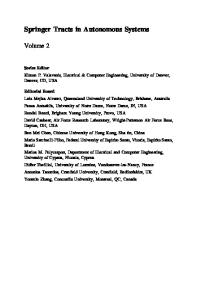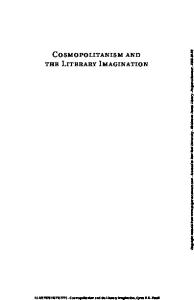Mapping the Imagination: Distinct Acts, Objects, and Modalities
- PDF / 537,934 Bytes
- 14 Pages / 439.37 x 666.142 pts Page_size
- 99 Downloads / 319 Views
Mapping the Imagination: Distinct Acts, Objects, and Modalities Rudolf Bernet1
© Springer Nature B.V. 2020
Abstract This article begins by presenting the two most important transformations that establish a genuine Husserlian approach to the imagination: the first lies in the grasping of imagination, despite its essential differences with perception and hallucination, as an intuitive, or sensuous consciousness (thereby contrasting it with signification); the second lies in the insight that imagination, or better – phantasy –, requires no images, mental or otherwise (thereby contrasting it with image consciousness). Further, the distinction between pure and perceptual phantasies and their respective fictional objects is drawn out. A comparison between pure phantasy and memory, then leads to a closer look at the role of inner consciousness in pure phantasy and to a clarification of the ‘splitting of the subject’. The exploration of this split allows us to trace the role of the real-ego and the phantasy-ego in pure phantasy, which opens the exploration of phantasy as a consciousness of possibilities. This helps us gain clarity about the nature of both real and ideal possibilities and the respective modes of phantasy. Objects of phantasy also most easily lend themselves to an eidetic variation and to an insight into essences. Phenomenological essences concern the ideal possibility of real and ideal objects and of their experience. It is through their contribution to insight into the real and ideal conditions of possibility of different forms of intentional acts that acts of phantasy best show their potential for Husserl’s project of philosophy as a rigorous science. Imagination or fiction becomes, in his own words, the ‘vital element of phenomenology.’ The analysis of imagining occupies a central place in Husserl’s exploration of the different forms and modalities of intentional consciousness. Retracing Husserl’s footsteps, we will explore the essential difference between acts of a pure phantasy or quasi-perception and acts which represent an object by means of an image or a sign – without losing view of everything which separates the intuitive givenness of an imaginary object from the perceptive givenness of a real object. We will also pay * Rudolf Bernet [email protected] 1
Katholieke Universiteit Leuven, Leuven, Belgium
13
Vol.:(0123456789)
Husserl Studies
attention to how the imaginative re-presentation (Vergegenwärtigung) of an unreal intentional object differs from remembering the real object of a past experience. It will soon appear, however, that the opposition between objects that really exist, and objects that have no actual existence, is insufficient to fully account for the nature of acts of imagination and their intentional objects. Imagined unreal or fictional objects can, indeed, also be objects of a possible real experience. Imagined objects can possibly become real objects and then lend themselves to an actual perception. For this, the content of imagination must comply with both o
Data Loading...











